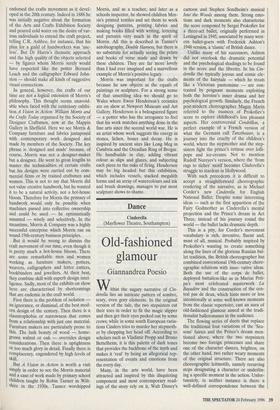Dance
Cinderella (Mayflower Theatre, Southampton)
Old-fashioned glamour
thannandrea Poesio
Within the sugary narrative of Cin- derella lies an intricate pattern of sombre, scary, even gory elements. In the original version of the tale, the two stepsisters cut their toes in order to fit the magic slipper and then get their eyes pecked out by some crows; while in some south European varia- tions Cinders tries to murder her stepmoth- er by chopping her head off. According to scholars such as Vladimir Propp and Bruno Bettelheim, it is this palette of dark tones that provides the backbone of the myth and makes it 'real' by being an allegorical rep- resentation of events and emotions from the every day.
Many, in the arts world, have been attracted and inspired by this disquieting component and most contemporary read- ings of the story rely on it, Walt Disney's cartoon and Stephen Sondheim's musical Into the Woods among them. Strong emo- tions and dark moments also characterise the score composed by Sergei Prokofiev for a three-act ballet, originally performed in Leningrad in 1945, associated by many west- ern ballet-goers with Frederick Ashton's 1948 version, a 'classic' of British dance.
Unlike many of his successors, Ashton did not overlook the dramatic potential and the psychological shadings to be found in the score and the libretto. In his Cin- derella the typically joyous and comic ele- ments of the fairytale — which he treats like a Victorian pantomime — are con- trasted by poignant moments exploiting both the heroine's inner drama and her psychological growth. Similarly, the French post-modern choreographer Maguy Marin referred to the nuances of Prokofiev's score to explore childhood's less pleasant aspects. Her controversial Cendrillon, a perfect example of a French version of what the Germans call Tanztheater, is a journey into the cruelty of the children's world, where the stepmother and the step- sisters fight the prince's retinue over lolli- pops and ice-creams. Not to mention Rudolf Nureyev's version, where the 'from rags to riches' motif becomes Cinderella's struggle to stardom in Hollywood.
With such precedents it is difficult to accept a straightforward choreographic rendering of the narrative, as in Michael Corder's new Cinderella for English National Ballet. Despite some interesting ideas — such as the first apparition of the Fairy Godmother as Cinderella's mental projection and the Prince's dream in Act Three, instead of his journey round the world — the ballet lacks dramatic depth.
This is a pity, for Corder's movement vocabulary is rich, inventive, fluent and, most of all, musical. Probably inspired by Prokofiev's wanting to create something along the lines of the glorious Russian bal- let tradition, the British choreographer has combined conventional 19th-century chore- ographic solutions with inno- vative ideas. Both the use of the corps de ballet, deployed battalion-like as in Marius Peti- pa's most celebrated masterwork La Bayadere and the construction of the cen- tral pas de deux, which hints more or less intentionally at some well-known moments from the classic repertoire, cast an aura of old-fashioned glamour aimed at the tradi- tionalist balletomanes in the audience.
The flowing series of duets that replace the traditional four variations of the 'Sea- sons' fairies and the Prince's dream men- tioned above, where the two stepsisters become two foreign princesses and share one of the character dances, brighten, on the other hand, two rather weary moments of the original structure. There are also choreographic leitmotifs, namely recurring steps designating a character or underlin- ing a specific moment in the action. Unfor- tunately, in neither instance is there a well-defined correspondence between the choreographic layout and the dramatic development; the dancing is therefore overwhelming and leaves no interpretative freedom to the artists, whose characters become flimsy and two-dimensional.
This is probably the first time I have seen two stepsisters who are neither comic nor evil, despite being beautifully danced (English National Ballet is a company blessed with first-rate dancers such as Lisa Pavane, Greg Horsman, Elizabeth Miegge, Monica Perego, Ambra Vallo, Giuseppe Picone, Rebecca Sewell, Yat Sen Chang). A member of the audience commented that 'there are too many steps', and, in a sense, he was right, for some 'acting' would not have done any harm as well as a bit of trimming here and there.



























































 Previous page
Previous page